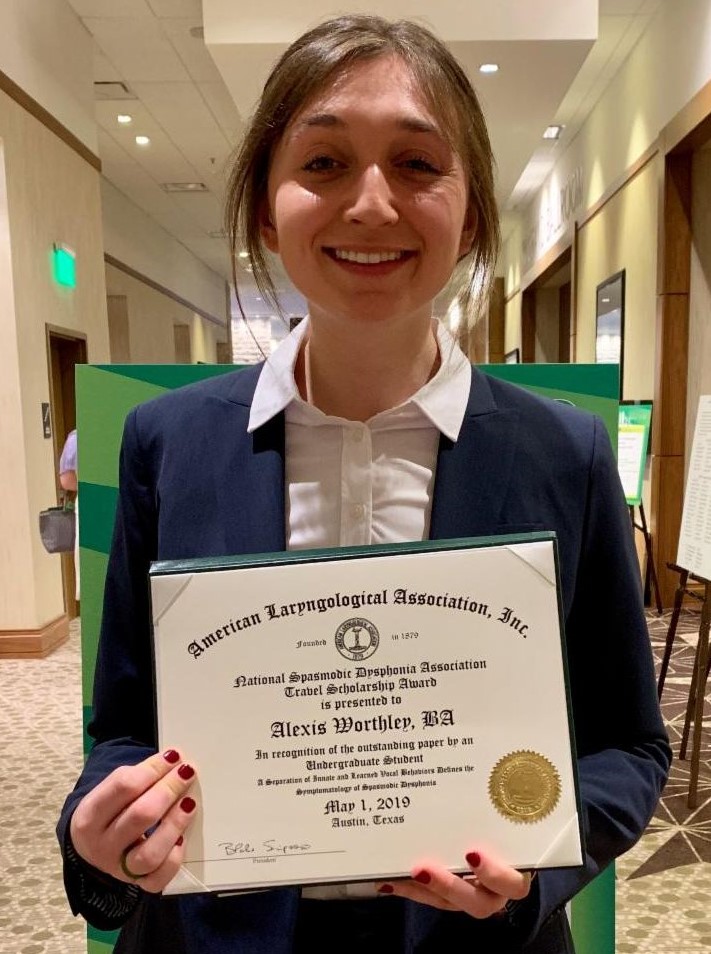Alexis Worthley, BA | Massachusetts Eye and Ear Infirmary

Alexis Worthley received an NSDA Research Travel Award to present her poster at the 2019 American Laryngological Association (ALA) Annual Meeting. She is a Research Assistant in the Dystonia and Speech Motor Control Lab led by Dr. Kristina Simonyan at Massachusetts Eye and Ear Infirmary in Boston, MA. Alexis shared, “Our study examined patients’ perspectives of their spasmodic dysphonia (SD) symptoms. While clinical symptomatology of SD is well described, research on patients’ own understandings of their SD symptoms is largely missing in current literature.
Exploring this critical perspective of SD provides further understanding of this disorder, which provides opportunity to improve diagnostic criteria and develop new treatment methods.” When ask about what it meant to the attend the meeting, she said, “Attending this meeting and presenting our findings provided me the opportunity to share what my colleagues and I learned about patient’s perspectives of spasmodic dysphonia symptoms. For me, this means I was given the opportunity to shed light on a critical component of the disorder, and share this information with physicians who work directly with this medical condition. I greatly appreciated the opportunity to do this.” Below is an abstract of her poster.
CONTRIBUTING AUTHORS: Samantha Guiry, BA, Alexis Worthley, BA, and Kristina Simonyan, MD, PhD PUBLISHED: Laryngoscope, 9999:1–7, 2018
OBJECTIVE: Spasmodic dysphonia (SD) is a neurological disorder characterized by involuntary spasms in the laryngeal muscles. It is thought to selectively affect speaking while other vocal behaviors remain intact. While clinical symptomatology of SD is well described, research on patients’ own understandings of their SD symptoms is largely missing in current literature. Exploring this critical perspective of SD provides further understanding of this disorder, and provides opportunity to improve diagnostic criteria and develop new treatment methods.
METHODS: A cohort of 178 SD patients rated their symptoms on the visual analog scale based on the level of effort required for speaking, singing, shouting, whispering, crying, laughing, and yawning. Statistical differences between the effort for speaking and the effort for other vocal behaviors were assessed using nonparametric Wilcoxon rank-sum tests within the overall SD cohort as well as within different subgroups of SD.
RESULTS: Speech production was found to be the most impaired behavior, ranking as the most effortful type of voice production in all SD patients. In addition, singing required nearly similar effort as speaking, ranking as the second most altered vocal behavior. Shouting showed a range of variability in its alterations, being especially difficult to produce for patients with adductor form, co-occurring voice tremor, late onset of disorder, and familial history of dystonia. Other vocal behaviors, such as crying, laughing, whispering, and yawning, were within the normal ranges across all SD patients.
CONCLUSION: Our findings widen the symptomatology of SD, which has predominantly been focused on selective speech impairments. We suggest that a separation of SD symptoms is rooted in selective aberrations of the neural circuitry controlling learned but not innate vocal behaviors


